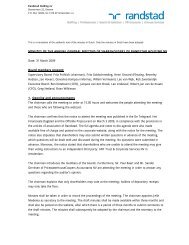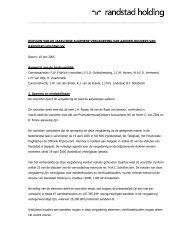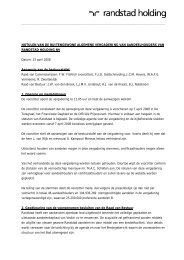randstad international trends and workplace survey report
randstad international trends and workplace survey report
randstad international trends and workplace survey report
You also want an ePaper? Increase the reach of your titles
YUMPU automatically turns print PDFs into web optimized ePapers that Google loves.
participant<br />
profile<br />
This chapter provides information about the people who have been<br />
interviewed: the sector they work in, their job title, as well as the<br />
number of staff members that <strong>report</strong> to the respondents. Information<br />
is given on how they found their current position <strong>and</strong> the degrees<br />
<strong>and</strong> certifications that are most common in their line of business.<br />
This chapter also illustrates the methods participants use to network<br />
<strong>and</strong> keep abreast on current business <strong>trends</strong>.<br />
Figure 4.1 Job level Figure 4.2 Department<br />
37% Management level<br />
24% Director level<br />
11% Employee level<br />
10% Supervisor level<br />
8% CEO / CFO / COO level<br />
3% Controller level<br />
3% Vice President level<br />
5% Other<br />
Most participants held a management title,<br />
followed by directors (fig. 4.1).<br />
As shown in fig. 4.2, most respondents worked<br />
in HR. Finance followed at a great distance.<br />
In The Netherl<strong>and</strong>s, the majority of the<br />
respondents worked within a finance department.<br />
58% HR<br />
14% Finance<br />
9% Sales / Marketing<br />
5% Engineering<br />
2% IT<br />
12% Other<br />
23% of respondents had 1 to 2 people that<br />
<strong>report</strong>ed directly to them. 34% had no employees<br />
<strong>report</strong>ing directly to them.<br />
The participants found their current position<br />
predominantly through professional contacts <strong>and</strong><br />
referrals, through recruitment companies <strong>and</strong> by<br />
means of internal promotion (fig. 4.3).<br />
4<br />
<strong>r<strong>and</strong>stad</strong><br />
<strong>international</strong><br />
<strong>trends</strong> <strong>and</strong><br />
<strong>workplace</strong><br />
<strong>survey</strong> <strong>report</strong><br />
Internal promotion was popular in Turkey <strong>and</strong> in<br />
The Netherl<strong>and</strong>s the use of recruitment companies<br />
scored the highest. Finding a job position through<br />
job fairs, an internal recruiter or the company<br />
website was not very common.<br />
The preferred methods of networking were<br />
attending conferences <strong>and</strong> conventions <strong>and</strong><br />
through professional <strong>and</strong> social networking sites.<br />
Mentors <strong>and</strong> coaches were unpopular, as shown<br />
in fig. 4.4.<br />
In The Netherl<strong>and</strong>s, Greece, Switzerl<strong>and</strong> <strong>and</strong><br />
Pol<strong>and</strong>, networking by means of attending conferences<br />
<strong>and</strong> conventions was the most common.<br />
To keep up with current business <strong>trends</strong> (fig. 4.5) we<br />
see that networking, professional networking sites<br />
(LinkedIn) <strong>and</strong> professional associations were the<br />
most frequently used resources. In The Netherl<strong>and</strong>s,<br />
Chile <strong>and</strong> Pol<strong>and</strong> educational seminars scored the<br />
highest in this context. For Spain <strong>and</strong> Argentina,<br />
one of the most popular resources for keeping up<br />
with current business <strong>trends</strong> was trade journals.<br />
The <strong>survey</strong> showed that 81% of respondents<br />
were members of LinkedIn. In second place, with<br />
52% we find Facebook, followed at a distance<br />
by Twitter (25%). These sites are mainly used for<br />
networking, followed by connecting with friends<br />
<strong>and</strong> family, recruitment <strong>and</strong> looking for jobs. Plaxo<br />
was very popular in Switzerl<strong>and</strong> <strong>and</strong> used by 45%<br />
of the respondents.<br />
12 R<strong>and</strong>stad <strong>international</strong> <strong>trends</strong> <strong>and</strong> <strong>workplace</strong> <strong>survey</strong> <strong>report</strong> 2013 R<strong>and</strong>stad <strong>international</strong> <strong>trends</strong> <strong>and</strong> <strong>workplace</strong> <strong>survey</strong> <strong>report</strong> 2013<br />
13<br />
2013<br />
Figure 4.3 How did you find your current role?<br />
Professional contact / referral 29%<br />
Recruitment company 15%<br />
Internal promotion 14%<br />
Internet job board 9%<br />
Executive search firm 8%<br />
Prof. networking site 4%<br />
Print advertising 2% -<br />
Internal recruiter 3%<br />
Print advertising 7% Other 8%<br />
networking by means of professional<br />
networking sites, such as linkedin are very<br />
popular to keep current on business <strong>trends</strong><br />
Company website 2% -<br />
Figure 4.4 Methods you use to network<br />
Conferences / conventions 57%<br />
Professionals networking sites 54%<br />
Social networking sites 36%<br />
Higher level professionals 29%<br />
Alumni associations 25%<br />
Mentors <strong>and</strong> coaches 11%<br />
Other 4%<br />
None 6%<br />
Figure 4.5 Resources most frequently used to stay abreast<br />
of business <strong>trends</strong><br />
Networking 58%<br />
Professional networking sites ( ) 52%<br />
Professional associations 50%<br />
Newspapers 46%<br />
Trade journals 40%<br />
Web based sources (blogs, eNewsletters) 40%<br />
Social networking sites ( ,<br />
) 22%<br />
Government tax authorities 16%<br />
Other 5%<br />
None 3%

















